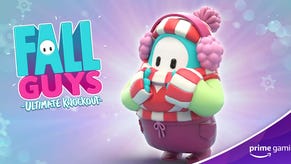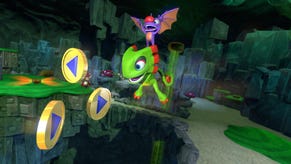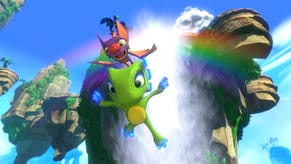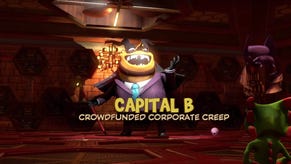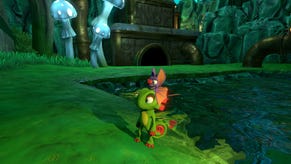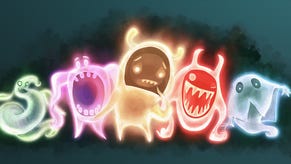Steve Mayles and Grant Kirkhope Talk About Yooka-Laylee
During E3, we talked to Playtonic's character art director and music composer about the spiritual successor to Banjo-Kazooie.
This article first appeared on USgamer, a partner publication of VG247. Some content, such as this article, has been migrated to VG247 for posterity after USgamer's closure - but it has not been edited or further vetted by the VG247 team.
One of the games I really enjoyed checking out at E3 a few weeks ago was Yooka-Laylee. It's an open-world 3D platformer that's reminiscent of the classic Rare N64 game, Banjo-Kazooie. There's a reason for that: The Yooka-Laylee team are comprised of several ex-Rare folk who actually worked on the Banjo-Kazooie games, and they consider their upcoming release to be a spiritual successor to that much-loved series.
After looking at Yooka-Laylee, I got the chance to briefly sit down with character art director Steve Mayles and music composer Grant Kirkhope to chat to them about their new creation.
USG: Yooka-Laylee seems to be almost like a metroidvania. There are sections of the game that you can go back to and unlock. How does that aspect of the game work?
Steve Mayles: We've tried to make Yooka-Laylee a little less linear than these games have been in the past. We've tried to add things around player choice like the way you can expand worlds, or not expand them – the choice is yours. If you want to progress quickly and see every new level, you can do that, and there are gameplay choices around the tonics where you can tailor the game to suit your playstyle. So if you're having a problem with a particular challenge, you can power-up one particular element with a tonic. Players will be able to take different paths through the game that way.
You can start in the first world and it's not expanded, and you could collect enough paiges to move onto the second world, or you could choose to stay where you are and expand the first world. If you go to the second world, you can go back and expand that first world anytime you wish. It'll probably be possible to go through the game without expanding any of it – although I don't know why you would, because you'd be missing out on huge chunks of gameplay.
Grant Kirkhope: Some people do want to rush through. It's giving the people who want that the opportunity to do so.
USG: Speedrunning, essentially?
GK: Yeah. We wanted to give people the chance to do that. And then there are people who want to do the full RPG thing and find every collectible, get everything, and achieve 100% in the game. It's a bit like Mario. You can go through the game without getting everything. But most people want to get everything, because that's fun.
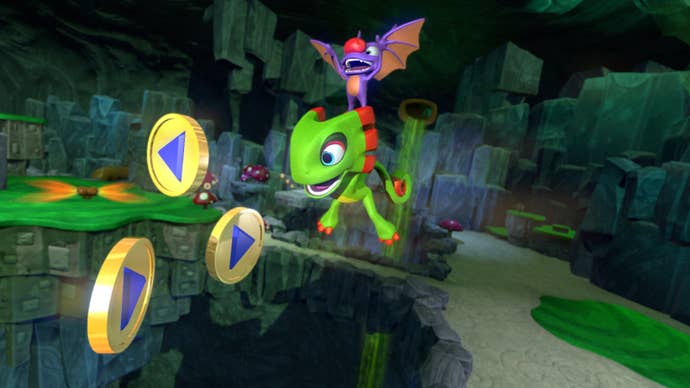
USG: How did you come up with the characters? A bat and a chameleon seem so random.
SM: There's some method behind the madness here. I started out with a tiger, but that never got past a 2D sketch. Then I was thinking that these characters in the past have been more underdogs. So I went back to the drawing board, and because we've done these sorts of games before, I started to think about abilities. What could they do that would make them interesting to play in terms of all the moves they could do? For example, the chameleon has obviously got his tongue and his tail, and has camouflage. So we can take those things and gamify them, so instead of camouflage just blending in with the background, now it takes on physical properties like metal, or fire, or electricity. It's the same with the bat – it had to fly because we needed to have those moves in the game. It couldn’t be a bird because of that other game we made, so a bat was a good option. Again, probably under-represented in games, and there are abilities around the bat's sonar moves we could bring into the game. Combining those moves together, especially with the physical properties aspects, and the way you can fire different projectiles, you end up with a lot of different combinations of moves.
Laylee's projectiles are completely different to the physical properties of Yooka. They're on a timer, so it's not like Banjo-Kazooie where you could pick up an egg and have it for the whole game if you didn't fire it. Because it's a time-specific thing, it lets us set up certain types of puzzles, because you only have a certain amount of time to do something. This is where things like the tonics come into play – because you might want to get a tonic that extends the amount of time that you can breathe fire.

USG: How are you going to set the difficulty of the game?
GK: Kazooie was easier, and Tooie was harder. We're trying to get a decent split between hard and easy. We'll have a decent spread of things to do – so maybe people can get through the game without having to do the really tough stuff.
SM: It's about not putting in too many tough things that are in critical parts of the game that players can't get past. I think you can get away with that later in the game, but most of the tough things will be off the beaten track – you'll have to go looking for them.
GK: There's nothing worse than getting to a part of the game and getting stuck on it, and you get sick of trying to get past it and you give up. You can get to the point where you do something so many times you get fed up of it, and we definitely want to avoid that. If you want to find the tough stuff in the game, you can choose that path and go down it.
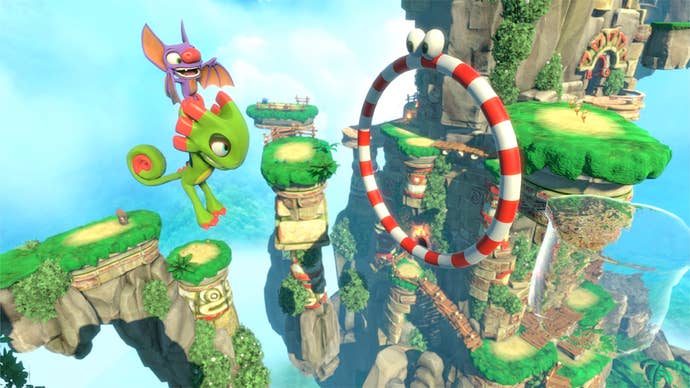
USG: Tell me a little about Yooka-Laylee's design aesthetic. It feels reminiscent of an N64 game. Is that deliberate?
GK: But it's not a retro-game, right? It's something we've been really conscious of musically and graphically, to try and pull some bits out of the early games, but we wanted to make something that feels new. So we were very cognizant of trying to keep the warmth, and making a game that makes you smile because it's great to see that kind of game. So we're keeping that in there, and adding new things too. Because hopefully we're better games makers now than we were 20 years ago. There's no guarantees obviously, but hopefully we are.
SM: We want it to be familiar to the old players, but then we don't want to exclude any new players. That's why we brought in the new stuff, and the graphics aren't retro in any way. So we don't see why we can't cover all ages.
USG: The aesthetic is more the colors, the brightness, the jolliness of the fonts and the text, and the way that the characters talk. That feels very familiar.
SM: Yeah. Those sorts of things are purposely retro, like the little talking heads. We actually rendered those as sprites like we used to on the N64. That was a definite choice. The collectibles are also rendered sprites. That helps capture the look of those old games. It's a nice throwback to those times.
GK: I saw somebody review the trailer the other day, and the comment was, "it just makes you smile," and I think that's a really great way of talking about the game. I just want people to look at it and go, "that's just great." It's friendly and colorful, and it's got a certain kind of humor. We just want people to smile and laugh at the game.
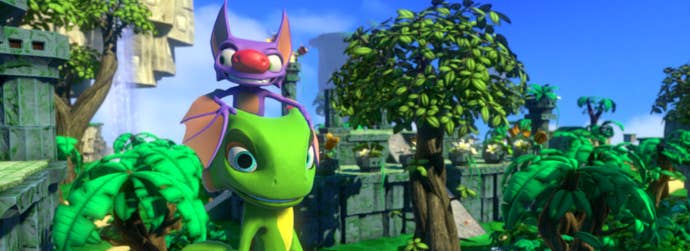
USG: Humor seems to be a very important aspect of the game.
GK: People think about Banjo-Kazooie like it's scripted humor. It wasn't really. The making fun of each other that we used to do back in the barn at Rare – shouting at each other down the corridor, the nicknames we called each other, and all that stuff. That humor just bled into the game, and that was how we messed around back in those days – and it's just the same now. It's almost like Banjo-Tooie was yesterday and Yooka-Laylee was today, and that 18 years hasn't happened and we're all back to square one again. Even though we're older now, and have wives and kids and mortgages, and all that, the silly nicknames and the making fun is still the same. Nothing has changed for us, and so that humor is going to be back in the game again because that's the way we like it.

